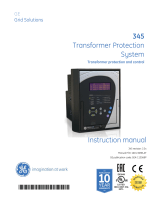6. Control
The IED offers control of one circuit breaker
(by default HV side circuit breaker) with
dedicated push-buttons for opening and
closing. Interlocking schemes required by the
application are configured with the signal
matrix in PCM600.
7. Measurement
The IED continuously measures the high
voltage (HV) side and the low-voltage (LV)
side phase currents and the neutral current of
the protected transformer. In addition, the
IED calculates the maximum current demand
value over a user-selectable pre-set time
frame and the symmetrical components of the
currents. Calculated values are also obtained
from the protection and condition monitoring
functions of the IED.
The values measured can be accessed locally
via the user interface on the IED front panel
or remotely via the communication interface
of the IED. The values can also be accessed
locally or remotely using the web-browser
based user interface.
8. Disturbance recorder
The IED is provided with a disturbance
recorder featuring up to 12 analog and 64
binary signal channels. The analog channels
can be set to record either the waveform or
the trend of the currents and voltage
measured.
The analog channels can be set to trigger the
recording function when the measured value
falls below or exceeds the set values. The
binary signal channels can be set to start a
recording on the rising or the falling edge of
the binary signal or both.
By default, the binary channels are set to
record external or internal IED signals, for
example the start or trip signals of the IED
stages, or external blocking or control
signals. Binary IED signals such as a
protection start or trip signal, or an external
IED control signal over a binary input can be
set to trigger the recording. The recorded
information is stored in a non-volatile
memory and can be uploaded for subsequent
fault analysis.
9. Event log
To collect sequence-of-events (SoE)
information, the IED incorporates a non-
volatile memory with a capacity of storing 50
event codes with associated time stamps. The
non-volatile memory retains its data also in
case the IED temporarily loses its auxiliary
supply. The event log facilitates detailed pre-
and post-fault analyses of feeder faults and
disturbances.
The SoE information can be accessed locally
via the user interface on the IED front panel
or remotely via the communication interface
of the IED. The information can further be
accessed, either locally or remotely, using the
web-browser based user interface.
10. Recorded data
The IED has the capacity to store the records
of four latest fault events. The records enable
the user to analyze the four most recent
power system events. The available
measurement modes include DFT, RMS and
peak-to-peak. In addition, the maximum
demand current with time stamp is separately
recorded. By default, the records are stored
in a non-volatile memory.
Transformer Protection and Control 1MRS756891 B
RET615
Product version: 2.0 Issued: 01.10.2009
ABB 13





















